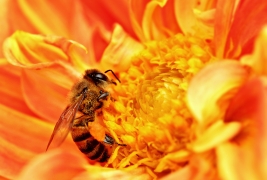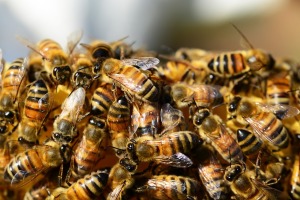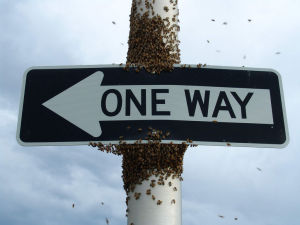by Melissa Gunter
Pollen can be transferred via wind, gravity, water, mammals, birds, bats or insects. Out of the approximately 100 crop species that provide 90 percent of the world’s food, 71 are pollinated by bees. Pollination is necessary to begin seed and fruit production in flowers. Approximately 90 percent of all plant species require the assistance of animals for pollination. Some crops such as almonds and blueberries do not produce fruit in the absence of pollinators. The most common pollinator is the European honey bee (scientific name Apis mellifera) and is responsible for pollinating one-third of the food consumed by Americans. Within a day of the life of a bee, which spans from six weeks in the summer to four to nine months during the winter, several thousand flowers over an 80-square mile area around the hive can be visited.
The primary crop types that require pollination in Florida are fruits and vegetables including citrus, squash, watermelon, cucumber and pumpkin. Although there are various methods of natural pollination, when a crop is pollinated by insects, the crop will yield an increased quantity, larger size and better product shape and enhanced taste.
Bees are recognized for their work in developing hive products such as honey and beeswax but their work as crop pollinators is the most significant contribution to agriculture. Pollination services are provided throughout the United States and consist of managed honey bee colonies that are transported two to three times during the nectar-producing season. The bee industry in Florida produces a quantity of honey valued at $8 million to $11 million annually. On a national scale, the value of United States crops pollinated by honey bees in 2010 was valued around $12.4 billion worth of directly dependent crops and $6.8 billion of indirectly dependent crops.
Although there is an expected loss in bees over the course of the year, such as a rate of 15 percent during the winter seasons, the rate has been averaging an unsustainable 30 to 31 percent of colonies annually in the United States since 2006. This widespread bee loss has been deemed as colony collapse disorder. Characteristics of colony collapse include the sudden loss of worker adult bees with few to no dead bees around the colony, the presence of capped brood, which references the three developmental stages of the bee, and food stores remaining present within the hive. Indications that a colony is collapsing include the presence of a workforce that is primarily composed of younger adult bees although the hive does not contain enough bees to take care of the colony brood and the bees that are within the hive are reluctant to consume food provided by the beekeeper.
There has been an overall trending decline in honey bee populations since the 1940’s at which time 6.5 million honey bee colonies were being managed in the United States, compared to the current quantity of approximately 2.6 million. Large-scale colony losses were previously documented in Florida during 1915 and 1978 and were attributed to causes such as pathogens, weather, genetics and management. Although declines in colonies are occurring throughout the United States, Florida is currently experiencing an increase in the number of colonies. In 2013, Florida had 3,000 beekeepers and approximately 350,000 colonies out of the 2.6 million managed colonies in the United States. This increase has been attributed to education and extension programs and consumer and media focus on honeybees and the causes and impacts of colony collapse disorder.
There is not a single culprit of the honey bee colony collapse disorder but a myriad of stressors, including poor nutrition, pesticides, stress from traveling, pathogens and pests that are compounding the effects of one another. It has been determined by the United States Department of Agriculture and the Environmental Protection Agency that a major contributor to the collapse of honey bee colonies is the parasitic Varroa destructor mite. The Varroa mite feeds on the adult bee’s hemolymph (bee blood) and the developing honey bee larvae. It can also transmit disease and trigger chemical treatment as a management approach. The mite is but one piece of the story.
Other contributing factors include deficiencies in honey bee nutrition, viruses, bacterial disease, chemicals used for pest control in the bee colonies and those encountered in the surrounding environment. Multiple viruses have been linked to colony collapse disorder and the levels of these viruses can be increased by the presence of the Varroa mite as well as deficient nutrition, environmental chemicals, pathogens and the age of the bees.
The American foulbrood bacteria, which affect the bee during the larval and pupal developmental stages, can impact the gut microbes. The microbes within the gut of the honey bee detoxify chemicals, encode enzymes that breakdown dietary components and protect against disease. As with humans, nutritional composition of the food that we consume influences our immune system and the functions of the immune system are directly related to the health of our digestive system. Thus, malnourished bees exhibit an increased susceptibility to parasites, pathogens and stressors. Bees can become malnourished when they are in monoculture environments that cause them to feed on nectar of one type of plant and thus not receive all of the required amino acids.
Nectar is the primary source of minerals and carbohydrates for the bees, which provides energy, whereas pollen contains protein, fats, vitamins and minerals. Thus, the health and diversity of flowering plants correlates to the health of the bees. Exposure to systemic pesticides such as neonicotinoids, which are absorbed by a plant through exposed seeds, soil or leaves, can lead to an increase in an immature bee’s susceptibility to the gut pathogen Nosema. Nosema and the Varroa mite can reduce the activation of the immune system and negatively impact nutrient utilization. Nosema can also cause symptoms such as low honey yields and greater than average fall/winter colony deaths.
Additionally, insecticides such as pyrethroids that are applied directly to the plants or drift onto flowers in the vicinity of crops, can pose greater damage on a cumulative level due to more frequent exposure opportunities. Even when pesticides are not responsible for immediate death in bees, exposure can lead to effects on bee behavior and susceptibility to disease. Some pesticides have been attributed to causing disturbance in the orientation abilities and a reduction in the lifespan of worker bees.
According to the United Nations, the earth is losing between 1 and 10 percent of natural habitats per decade. The decline in natural habitats and the fragmentation of the habitat are having an impact on the pollinator populations due to the synergistic relationship between the availability and integrity of the natural habitat and bees. The availability of nutritional forage is crucial to the health of bees and land use pattern changes have led to less available forage for honey bee colonies. Access to diverse and healthy floral resources, which are related to the way that the land is managed around the colonies, leads to healthier bee colonies.
There are ways that we can be of assistance to the bee population. Such actions include:
- Planting native plants that provide nectar sources for honey bees. Lists of blooming plants in Florida can be found at http://edis.ifas.ufl.edu/in848 and http://www.americasbeekeeper.com/Honey_Plants_for_Florida.htm.
- Restrict the use of pesticides on a personal level as well as support farmers that are cultivating organic crops. Weeds offer a source of nutrition to bees but due to the application of weed control methods, this nutritional resource is not as available.
On a commercial level, steps that are necessary to lead to the improvement of the honey bee colony health and thus their survivorship, includes habitat enhancement, targeted pesticide application techniques, improved colony management techniques, diversification of the agriculture landscape to increase resource availability for pollinators and disease and pest resistant bee stocks.
Management of the effects of pesticides on pollination and honey bee production can be enhanced through improvement in communication between stakeholders, the establishment of alternative forage such as pesticide-free areas with blooming plants and the implementation of best management practices. Best management practices are practical and effective methods that can be conducted to protect and enhance the health of honey bee colonies.
Although bees are not currently predicted to become extinct, if they continue to die at the rates indicative of colony collapse disorder, impacts could include a decrease in the availability of food and a subsequent increase in food costs. On a broader biological scale, honey bees are indicators of environmental health and the increased death rates of bees can be an indicator of a greater environmental imbalance.
Melissa Gunter works on behalf of the environment through passionate and creative approaches to protection, restoration, and policy development efforts. Her career and education background is balanced between environmental engineering and science.
References
- Ellis, A., Ellis, J., O’Malley, M., Zettel Nalen, C. (2013). The Benefits of Pollen to Honey Bees. University of Florida Institute of Food and Agricultural Sciences. http://edis.ifas.ufl.edu/in868.
- Kelso, Christina. (2013). Declining bee population could impact food supply; but Florida has largely escaped the colony collapse phenomenon affecting U.S. hives. Florida Times – Union. Jacksonville. http://christinakelso.com/wp-content/uploads/2013/09/072013-D-001-GA-LIFE_.pdf.
- Marks, Raissa. (2005). Natural Resources Conservation Service Wildlife Habitat Management Institute. Native Pollinators. Fish and Wildlife Habitat Management Leaflet No. 24.
- McLean, Melanie. (2013). New Drug Approved to Help Agriculture’s Helpful Honey Bees. U.S. Food and Drug Administration. http://www.fda.gov/AnimalVeterinary/ResourcesforYou/AnimalHealthLiteracy/ucm309134.htm.
- Pleasant, Barbara. (2010). Systemic Pesticides: Chemicals You Can’t Wash Off. Mother Earth News. http://www.motherearthnews.com/nature-and-environment/systemic-pesticides-zmaz10onzraw.aspx#axzz2ky8YKGFF.
- Ramanujan, Krishna. (2012). Insect pollinators contribute $29 billion to U.S. farm income. Cornell Chronicle. http://www.news.cornell.edu/stories/2012/05/insect-pollinators-contribute-29b-us-farm-income.
- Sanford, Malcolm. (2003). Sample Pollination Agreement. ENY110 Entomology and Nematology Department, Florida Cooperative Extension Service, Institute of Food and Agriculture Sciences, University of Florida. http://edis.ifas.ufl.edu/aa169.
- United States Department of Agriculture Office of Communication. (2013). USDA and EPA Release New Report on Honey Bee Health. http://www.usda.gov/wps/portal/usda/usdamediafb?contentid=2013/05/0086.xml&printable=true.
- United Stated Department of Agriculture. (2012). Report on the National Stakeholders Conference on Honey Bee Health. National Honey Bee Health Stakeholder Conference Steering Committee. http://www.usda.gov/documents/ReportHoneyBeeHealth.pdf.
- Underwood, R. and vanEngelsdorp, D. (2007). Colony Collapse Disorder: Have We Seen This Before? The Pennsylvania State University. Pennsylvania Department of Agriculture. http://ento.psu.edu/pollinators/publications/underwood.
Wilmoth, Kimberley. (2011). UF Scientists continue to study Colony Collapse Disorder. The Gainesville Sun. http://www.gainesville.com/article/20110406/articles/110409697.




Leave a Reply